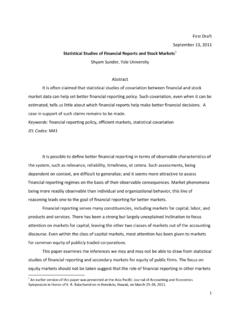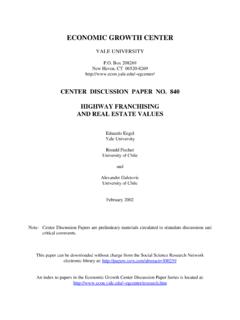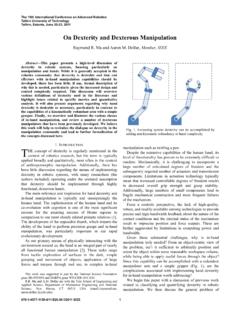Transcription of K. Sudhir Sumon Datta Yale School of Management
1 Pricing in Marketing Channels K. Sudhir Sumon Datta yale School of Management We thank the editor Vithala Rao and Jiwoong Shin for comments and suggestions on the paper. Pricing in Marketing Channels Abstract This paper provides a critical review of research on pricing within a channel environment. We first describe the literature in terms of increasing time horizons of decision making in a channel setting: (1) retail pass-through (2) pricing contracts and (3) channel design; all of which occur within a given market environment. We then describe the emerging empirical literature on structural econometric models of channels and its use in (1) inferring channel participant behavior and (2) policy simulations in a channel setting.
2 We also discuss potential areas for future research in each area. Pricing in Marketing Channels Price and Channel are two of the four elements of the marketing mix that managers control, yet they differ fundamentally in how managers can use them to impact market demand. While price is the most flexible, in that managers can change it most easily to impact short-run demand, the distribution channel through which firms reach their end consumer is the least flexible and perhaps the costliest to change in the short run. Therefore, channel design is viewed as part of a firm s long run strategy. Most importantly, in the presence of a typically decentralized distribution channel, an upstream price change by a manufacturer does not affect consumer demand directly, but only through how this upstream price change affects the retail price set downstream in the channel.
3 In his review of the pricing literature, Rao (1984) stated that the issues of pricing along the distribution have not received much attention in the literature. However, over the last 25 years, this gap has been remedied substantially. The tools of game theory have revolutionized the theoretical analysis of pricing within the channel and clarified the many issues about how prices are set within a channel; more importantly, these analyses have given insights on the optimal long-term channel strategy, given how prices will be set within the channel. A smaller but emerging empirical literature on structural models of channels has provided us insights on the behavior of channel participants and tools to perform policy analysis in a channel setting.
4 The purpose of this article is to provide a critical review of this literature, identify the key themes of understanding that have emerged from research to-date and to identify important gaps in our knowledge that would benefit from future research. Given the short-run nature of price and the long-run nature of the channel, we organize the literature in terms of three key issues of managerial interest that progressively increase in their time horizons for the decision. The three sets of questions are: 1. Conditional on the distribution channel (which is fixed in the short run) and other market characteristics, how can a change in upstream price affect the downstream price seen by the end consumer?
5 This question of pass-through is the most short-term of the three sets of decisions we consider. Pass-through is of interest to an upstream manager because it determines the extent to which the upstream manufacturer will change prices. 22. Conditional on the distribution channel (which is fixed in the short run) and other market characteristics, what is the best pricing contract to offer to the downstream channel member? This is a medium term decision, where managers set the rules of their interactions within the existing channel structure. These contracts affect the objective function of the market participants; and managers seek contracts that maximize their profits given a chosen channel structure.
6 Pricing contracts can include linear tariffs, two part-tariffs, quantity discounts, slotting allowances, resale price maintenance (RPM) etc. Note that the types of pricing contracts that can be used may be constrained by law. 3. Finally, given the market characteristics, what is the optimal channel structure and the pricing contract? This is a long-term decision where managers decide on the nature of channel ownership given the market characteristics. Should a firm vertically integrate or decentralize? Or would a mixed strategy of partial integration, with the manufacturer directly selling along with independent retailers be optimal? The emergence of the Internet as a sales channel has brought the issue of partial forward integration again into focus in recent years.
7 Since the optimality of the channel structure would depend on the nature of pricing contracts that would be available to the manufacturer, channel structure design is intimately linked to the pricing strategy. Finally, all of these decisions are embedded in the market environment in which the firms operate. A schematic way about thinking about these three sets of managerial decisions embedded within a market environment is given in figure 1, where we have laid out each of these questions within concentric circles. The answers to the pass-through questions are linked to the pricing contracts, which are in turn linked to the questions about channel design, which in turn are linked to the market environment in which the firms operate.
8 Since no one paper can exhaust all possible combinations within the above framework to give us a complete understanding of the tradeoffs involved, one objective of this article is to identify generalizable themes across multiple papers that model different combinations of market environments, channel structures and pricing contracts. This exercise should also help us identify key gaps in the literature. We also describe the complementary empirical literature on structural models of channels that have emerged over the last decade. Such models serve to (1) describe manufacturer-retailer interactions that best describe the market and (2) perform policy analysis of various channel decisions.
9 3 Figure 1: Pricing Within a Channel: Key Issues Section 2 describes a basic game-theoretic model of channels to illustrate the key modeling issues. Section 3 discusses the pass-through literature, Section 4 discusses the pricing contracts and Section 5 discusses the literature on optimal channel structures. Section 6 reviews the literature on structural econometric models. Section 7 concludes. 2. An Illustrative Game-Theoretic Model of Channels: The Bilateral Monopoly McGuire and Staelin (1983) laid the foundation for game theoretic analysis of channels in marketing. At the heart of the channel pricing game-theoretic literature is the concept of double marginalization (Spengler 1950).
10 The concept is applicable whenever there are multiple decision makers setting prices in stages; but to make the idea concrete we illustrate double marginalization in the simplest setting of a bilateral monopoly. Consider the following bilateral monopoly setting as shown in Figure 2: a manufacturer who produces at a unit cost c, sets a wholesale price w to his retailer who in turn sets a retail price p to the consumer. Consumer demand follows a linear demand model: 1qp= . Channel Design Pricing Contracts Pass-through Market Environment 4 Figure 2: A Model of Bilateral Monopoly Given the sequential nature of the game, we solve for the optimal retail and wholesale prices by backward induction.









